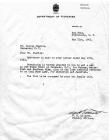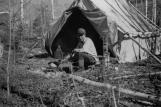1
CONTENTS:- New Rules for Hunting, Trapping & Fishing
- "Prime Real Estate" and Indian Reserves
2
New Rules for Hunting, Trapping and FishingIt did not take long for the K'uch'an arrivals to set up a European-style governement, and very soon they began forcing rules upon First Nation peoples. Where they had once depended upon First Nations as guides and providers, the K'uch'an now sought more control over Yukon lands and resources by restricting First Nations hunting and fishing.
In 1920, the North West Mouted Police (NWMP) began enforcing hunting regulations on First Nations people. They were now forbidden to kill female animals and to sell meat without a license. In the 1930s, the Canadian government banned the use of traditional fish traps, and replaced them with commercial nets. By 1947, the government required First Nations peoples to follow most hunting and fishing regulations. They now had to get licenses for everything, and observe closed seasons. Trapline registration began in 1952, with trapline boundaries set by the government.
Some of these issues have been settled through modern land claims, while others remain. Aboriginal rights to hunt, fish and trap for food at any time are now recognized, but the management of animal habitat, K'uch'an hunters, and registered traplines are still causing difficulties today.
5
"Prime Real Estate" and Indian ReservesThe K'uch'an newcomers were in conflcit with First Nation peoples over land almost as soon as they arrived in the Yukon. Many Hän people were displaced from their traditional camp of Tr'ochëk at the mouth of the Tr'ondëk (Klondike River) by gold rushers in 1897. Northern Tutchone people soon experienced similar problems, because they had chosen their homes very carefully and had camped in good spots. Once the K'uch'ans realized this, they were eager to take control of this "prime real estate".
By the 1950s, there were many K'uch'ans and Northern Tutchone living together at Carmacks. The Department of Indian Affairs began to set aside reserves for Northern Tutchone people in order to limit them to one small piece of land; the rest would be managed by the government. In 1956, Little Salmon Village was set aside as Indian Reserve No. 10.
In Carmacks, the local Indian Agent saw a need to move Nothern Tutchone people to a different living area than the white settlers. According to former Chief Taylor MacGundy and Elder Eva Billy, Indian Affairs wanted to create a reserve near the old airport in a swampy area. Taylor told the Indian Agent "We're not beavers, we can't live in that place". In 1958-59, Indian Affairs created a reserve on higher ground across the river, where the First Nation village is located today. These small reserves were to be the only land rights granted to First Nations people until the land claims era over 30 years later.

